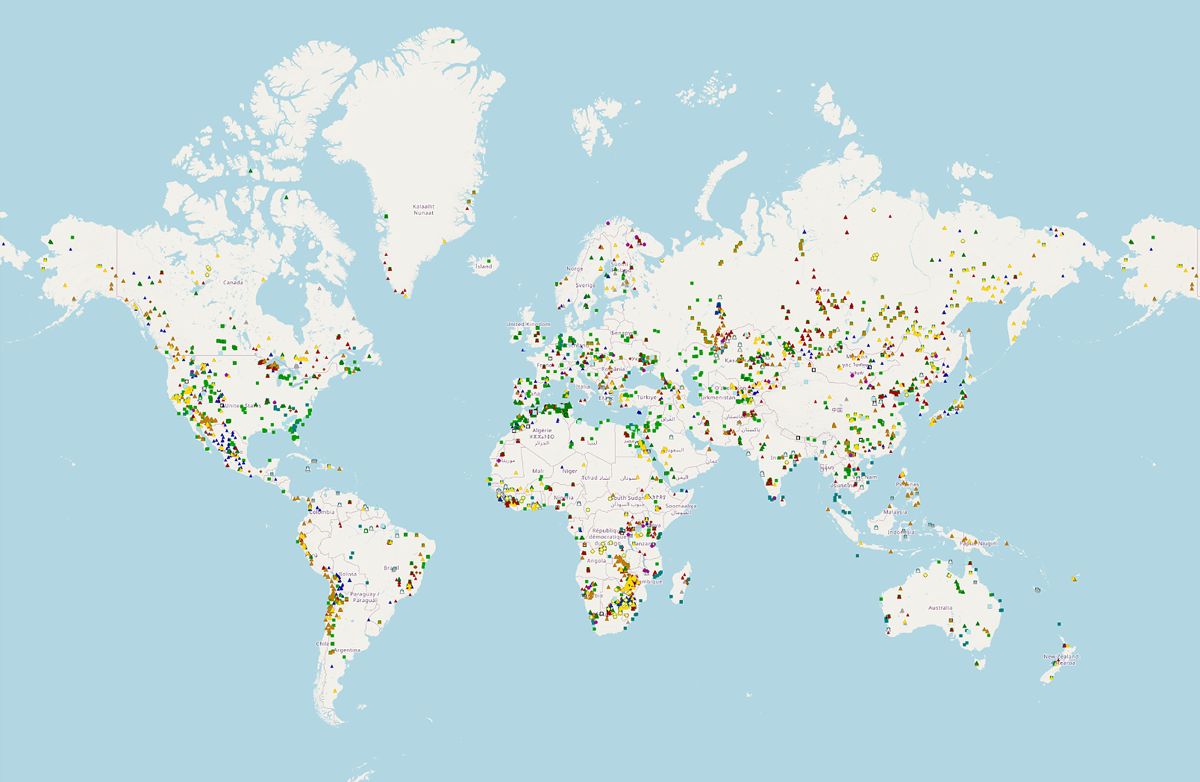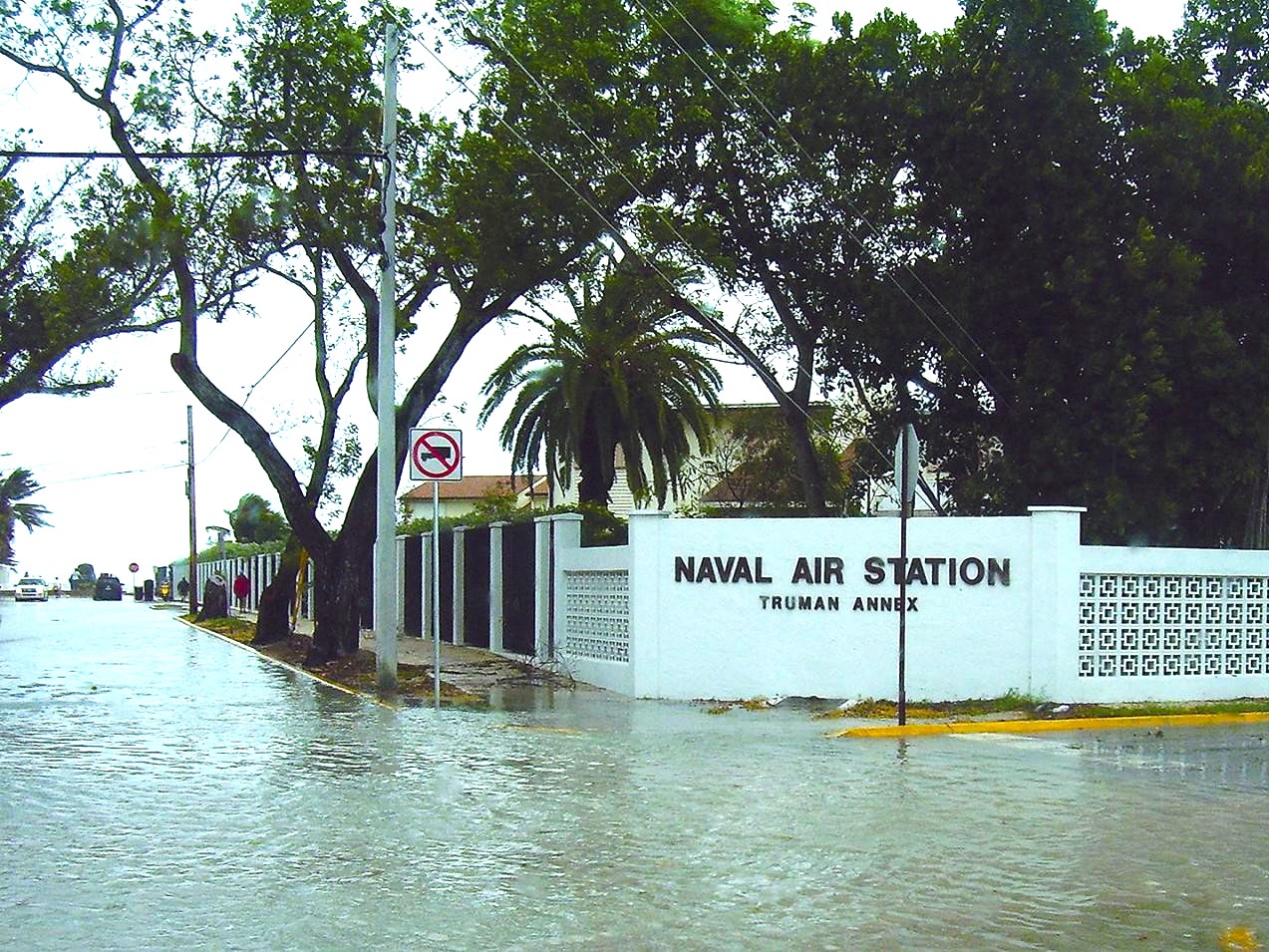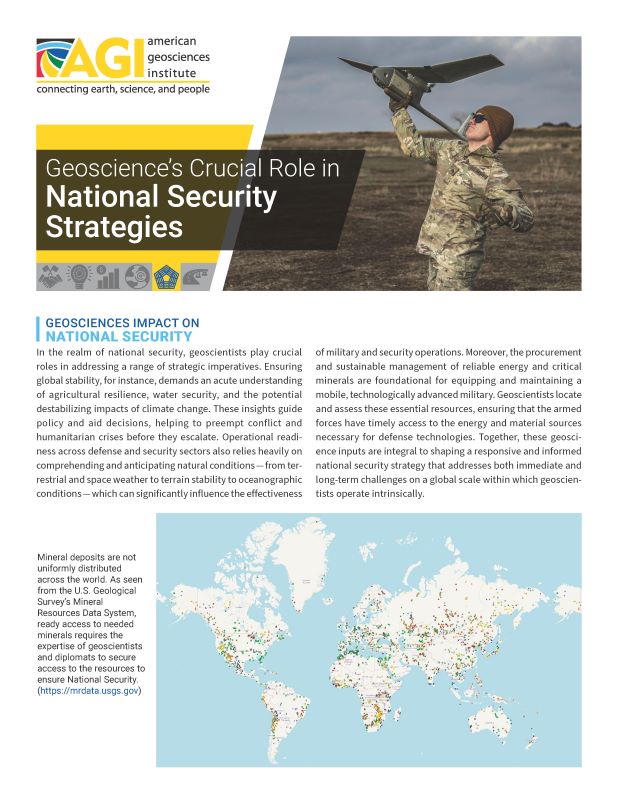Geoscience’s Crucial Role in National Security Strategies

Geoscience strengthens national security by ensuring critical mineral supplies, predicting natural hazards, and adapting to climate impacts which safeguards stability, supports defense operations, and enables resilient strategies for a secure future.
Geosciences Impact on National Security
Climate Adaptation
Geoscientists help our understanding of climate patterns and their impacts, aiding national security apparatus in preparing for and mitigating the effects of climate change, such as increased frequency of extreme weather events, implications on global stability, and threats to force readiness.
Critical Minerals
Critical minerals are essential to national security due to their irreplaceable role in manufacturing defense technology, renewable energy systems, and advanced electronics. These minerals, including rare earth elements, lithium, and cobalt, are integral components in everything from jet engines and communication satellites to missile guidance systems and electric vehicle batteries. The availability and security of these mineral supplies are vital to maintain technological superiority, economic stability, and strategic autonomy.
Disaster Preparedness and Response
Geoscientists are crucial in predicting natural disaster risks like earthquakes, tsunamis, and volcanic eruptions, which enables better preparedness and response strategies to protect populations and critical infrastructure.
Energy Security
Geoscientists are central to the exploration and development of energy resources, including fossil fuels and renewables such as geothermal, uranium for nuclear power, and helping to ensure a stable and independent energy supply.
Environmental Monitoring
Monitoring environmental degradation and its security implications, such as soil erosion, deforestation, and water shortage or contamination, which can lead to food and water scarcity and drive mass migrations.
Geopolitical Analysis
By mapping territorial waters and land boundaries, geoscientists aid in resolving territorial disputes and in strategic military planning, particularly in regions where borders are contested.
Oceanography for Naval Operations
Understanding oceanographic data assists naval operations in navigation, submarine warfare, and the deployment of marine assets, enhancing maritime security.
Space Weather Monitoring
Geoscientists involved in studying atmospheric sciences and solar-terrestrial interactions help predict space weather events that can disrupt satellite communications, navigation systems, and even power grids, all of which are critical to national security operations.
Exemplars of Impacts of Geoscience on National Security
Critical minerals are indispensable for both economic vitality and technological advancement, impacting national security directly. Direct investments by the US Defense Department in securing future cobalt supplies from a developing mine in Idaho to advances in brine-based lithium production are ways geoscientists are securing future supplies of minerals crucial for manufacturing advanced military hardware, from stealth technology to communication systems, and critical civilian technologies like smartphones and electric vehicles. A secure and sustainable supply of these resources ensures that a nation does not become overly dependent on potentially unstable foreign sources, thereby maintaining its strategic autonomy and technological edge.

Geoscientists significantly enhance national security by providing accurate weather, space weather, and other geological hazard forecasts. These capabilities are essential for planning and conducting military operations safely and effectively. Weather forecasting helps in strategic deployment of troops, while space weather alerts are critical for protecting satellites and communication systems from solar flares. Additionally, early warnings of geological hazards like volcanic eruptions or earthquakes can safeguard both military and civilian infrastructure, ensuring operational continuity.
Geoscience plays a pivotal role in promoting global stability by providing crucial data on climate change and environmental degradation, which can lead to food and water scarcity, impacting millions. By predicting these changes, geoscientists enable proactive international aid and intervention strategies, mitigating the risk of conflicts and unrest. Additionally, their work helps anticipate mass migrations caused by natural disasters or resource shortages, allowing for better preparedness and response, thereby preventing potential security crises before they arise.
Case Studies
Examples of Relevant Legislation and Policy
Executive Orders
- E.O. 13817: Focuses on America’s critical minerals. It mandates the identification of critical minerals and formulates a strategy to decrease the nation’s dependency on foreign sources. This EO underscores the importance of geoscience in assessing and developing domestic sources of these essential minerals to enhance national security (USGS).
Congressional Legislation
- 118th — S. 2031: This bill requires the Department of Defense (DOD) to develop supply chains that are not dependent on mining or processing of critical minerals in or by specified countries (e.g., China) to achieve critical mineral supply chain independence by 2035.
- 117th — H.R. 4559: Requires the DoD to consider climate implications on its contracting, both from the standpoint of reduction of carbon emissions and on making strategic decisions for basing based on climate resilience.
Relevant Federal Agencies
- US Department of Defense
- US Department of State
- Army Corps of Engineers
- U.S. Geological Survey
Related National Academy Reports
- Climate Intervention in an Earth Systems Science Framework: Proceedings of a Workshop–in Brief (2024)
- Planning the Future Space Weather Operations and Research Infrastructure: Proceedings of a Workshop (2021)
- Managing Materials for a Twenty-first Century Military (2008)
- Minerals, Critical Minerals, and the U.S. Economy (2008)
- Climate Security in Central America: Proceedings of a Workshop (2005)
Non-Partisan Non-Profit Expertise
- American Association of Petroleum Geologists
- American Geophysical Union
- American Institute of Hydrology
- American Institute of Professional Geologists
- Association of American State Geologists
- Association of Environmental and Engineering Geologists
- Geological Society of America
- National Groundwater Association
- National Sand, Stone, and Gravel Association
- Society of Economic Geologists
- Society of Exploration Geophysicists
- Society for Mining, Metallurgy, and Exploration


 The Department of Defense's Climate Risk Analysis is a comprehensive document that assesses the various risks posed by climate change to U.S. military operations and infrastructure. The analysis highlights how rising sea levels, increased flooding, and extreme weather events threaten military bases and other infrastructure. Both Naval Station Norfolk and Cape Canaveral Space Force Station are facing risks of ongoing flooding, and projected annual major floods by 2050. Total expected climate-related risk to bases is estimated at $387 billion. New initiatives emphasize the need for resilient designs and retrofitting existing facilities to withstand these changes. Additionally, climate change impacts are expected to complicate operational readiness and execution as altered weather patterns could affect training, logistics, and the ability to project force.
The Department of Defense's Climate Risk Analysis is a comprehensive document that assesses the various risks posed by climate change to U.S. military operations and infrastructure. The analysis highlights how rising sea levels, increased flooding, and extreme weather events threaten military bases and other infrastructure. Both Naval Station Norfolk and Cape Canaveral Space Force Station are facing risks of ongoing flooding, and projected annual major floods by 2050. Total expected climate-related risk to bases is estimated at $387 billion. New initiatives emphasize the need for resilient designs and retrofitting existing facilities to withstand these changes. Additionally, climate change impacts are expected to complicate operational readiness and execution as altered weather patterns could affect training, logistics, and the ability to project force.
